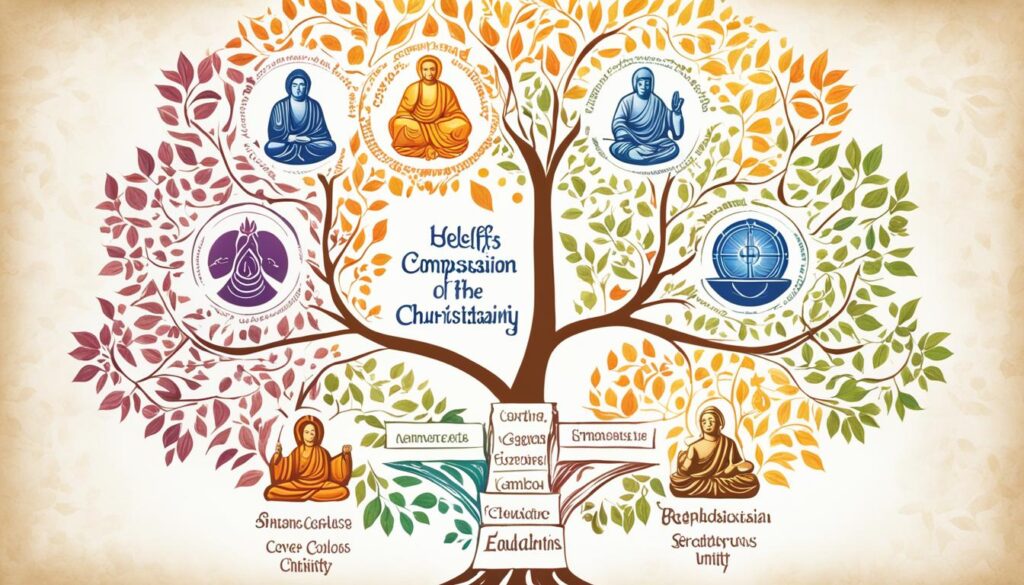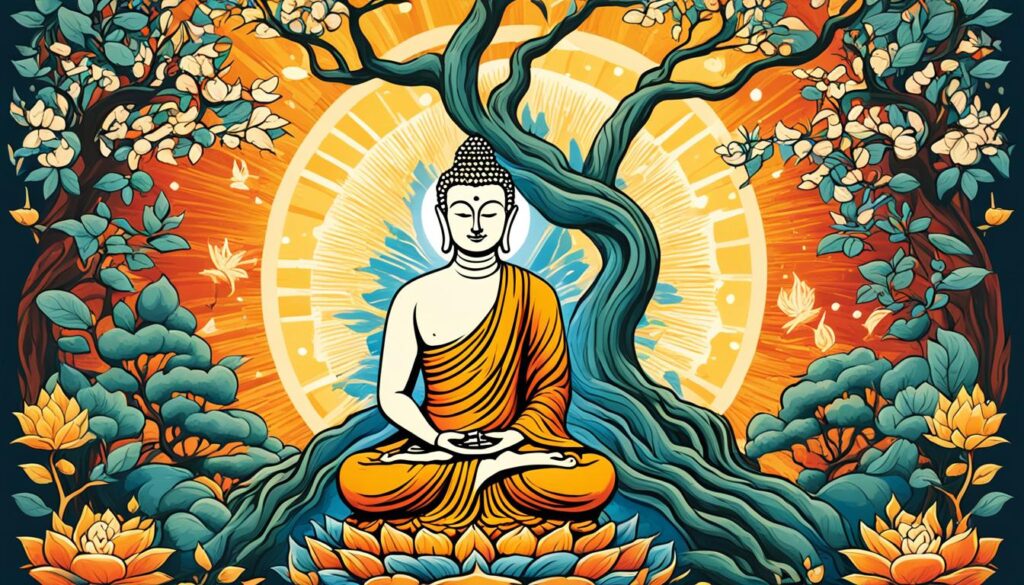Have you ever wondered how two seemingly different religions like Christianity and Buddhism could share common themes and principles? What if I told you that these ancient faiths have spiritual connections and shared values that can offer profound insights for personal growth and societal harmony? Let’s delve into the similarities between Christianity and Buddhism, exploring their religious beliefs, practices, and the cross-religious parallels that exist.
Key Takeaways:
- Christianity and Buddhism possess shared values and common themes, despite their apparent differences.
- Both religions emphasize compassion, mindfulness, and the search for personal and spiritual growth.
- Exploring the spiritual connections between Christianity and Buddhism fosters a deeper understanding of these faiths and helps bridge religious gaps.
- Comparative study of Christianity and Buddhism can lead to greater personal enlightenment and societal harmony.
- By embracing the similarities and shared critiques, we can find common ground and cultivate a more inclusive and tolerant world.
The Teachings of Buddha and Jesus
Buddha and Jesus, revered as enlightened beings in their respective religious contexts, challenged certain aspects of organized religion during their time. Despite existing in different historical periods and regions, the teachings of Buddha and Jesus share striking similarities. Both men emphasized the importance of looking within, finding inner peace, and radiating boundless love towards others. Their rebellious spirit and revolutionary approach to religion provide a strong foundation for understanding their shared quest to awaken humanity.
In Buddhism, the teachings of Buddha focus on the attainment of enlightenment through the Four Noble Truths and the Eightfold Path. Buddha taught that suffering is an inherent part of life, but it can be overcome by understanding its causes and following a path of ethical conduct, meditation, and wisdom.
Similarly, Jesus’ teachings in Christianity revolve around love, compassion, and forgiveness. He challenged the religious authorities of his time by emphasizing a personal relationship with God and redirecting focus away from external rituals and legalistic interpretations of the law. Jesus’ teachings promote a transformative inner journey that leads to spiritual liberation and connection with the divine.

By embracing the teachings of Buddha and Jesus, individuals can nurture their inner selves, cultivate compassion, and foster positive change in the world. Both spiritual leaders encourage followers to question established norms, challenge oppressive systems, and prioritize love and compassion in their interactions with others.
The Rebellion Against Established Authority
Both Buddha and Jesus exhibited a rebellious aspect in their teachings, which challenged the traditional religious frameworks of their time. Buddha questioned the caste system and the authority of Brahmins, advocating for a path to enlightenment that was accessible to all individuals, regardless of social status.
Similarly, Jesus challenged the religious authorities of his time and critiqued the excessive legalism and hypocrisy that he observed. By focusing on the inner transformation of the heart, Jesus emphasized love, compassion, and forgiveness as the keys to true spirituality, rather than mere adherence to external rituals and rules.
The Enlightenment and Revolution in Religion
Buddha’s enlightenment experience under the Bodhi tree marked a groundbreaking moment in the history of Buddhism. By attaining enlightenment, Buddha revolutionized the understanding of human suffering, introducing a path that leads to liberation and the end of suffering. His teachings provided a roadmap for individuals to uncover their true nature and transcend the limitations of ego.
Similarly, Jesus’ revolutionary teachings offered a new perspective on spirituality and the nature of the divine. He challenged the existing religious traditions by emphasizing the importance of personal transformation and the power of love. Jesus’ message of the kingdom of God called for a fundamental shift in consciousness and a radical reorientation of human values.
The World’s Religious Landscape
To understand the significance of Christianity and Buddhism, it is essential to consider the broader religious landscape. Christianity is the largest global religion, with approximately 31.5% of the world’s population identifying as Christians. Islam follows closely behind with 23.2%. Buddhism, accounting for 7.1% of the population, is a significant religious tradition with millions of practitioners worldwide. Examining the distribution and size of different religions highlights the widespread influence of both Christianity and Buddhism.
To give you a comprehensive view of the world’s major religions, here is a breakdown of the global population percentages:
| Religion | Percentage of Global Population |
|---|---|
| Christianity | 31.5% |
| Islam | 23.2% |
| Unaffiliated | 16.3% |
| Hinduism | 15% |
| Buddhism | 7.1% |
| Folk Religions | 5.9% |
| Other Religions | 0.8% |
| Judaism | 0.2% |

This visual representation of the world’s religious distribution showcases the prominent role that Christianity, Islam, Buddhism, Hinduism, and other traditions play in shaping the beliefs and practices of billions of people around the globe. It is indeed a vast and diverse spiritual tapestry, reflecting the human pursuit of meaning, higher purpose, and connection to the sacred.
Branches of Christianity and Buddhism
Both Christianity and Buddhism have branched out into various denominations and traditions, each offering unique perspectives and practices. Understanding the diversities within these religious frameworks enriches our exploration of spirituality and deepens our appreciation for the multifaceted nature of faith.
Branches of Christianity
In Christianity, three major branches have emerged throughout history:
- Catholicism: As the oldest and largest Christian denomination, Catholicism follows the teachings of Jesus Christ and recognizes the authority of the Pope. It embraces rituals, sacraments, and a hierarchical structure to guide the spiritual journey of its followers.
- Protestantism: Originating from the Protestant Reformation in the 16th century, Protestantism emphasizes the direct relationship between individuals and God, placing an emphasis on personal faith and interpretation of the Bible. It encompasses a wide range of denominations, including Lutheranism, Anglicanism, and Baptist.
- Eastern Orthodoxy: Eastern Orthodoxy developed in the Byzantine Empire and holds a rich tradition deeply rooted in the early Christian Church. It emphasizes liturgical worship, mystical spirituality, and the significance of icons in its religious practices.
Branches of Buddhism
Buddhism, a philosophy and religion originating in ancient India, has evolved into multiple traditions over time:
- Theravada Buddhism: Known as the “Way of the Elders,” Theravada Buddhism focuses on individual enlightenment through the practice of meditation and adherence to the teachings found in the Pali Canon. It is prevalent in Southeast Asia, including countries like Thailand, Myanmar, and Sri Lanka.
- Mahayana Buddhism: Mahayana Buddhism emphasizes compassion and the pursuit of enlightenment for the benefit of all sentient beings. This tradition encompasses various schools, such as Zen, Pure Land, and Tibetan Buddhism, and is widely practiced in East Asia.
- Vajrayana Buddhism: Vajrayana Buddhism, often referred to as Tibetan Buddhism, incorporates esoteric rituals, meditation practices, and the belief in enlightened beings called Bodhisattvas. It is particularly practiced in Tibet, Bhutan, and parts of Nepal and India.
- Other Buddhist Traditions: Besides the major branches mentioned above, there are also numerous smaller Buddhist traditions influenced by local cultures and customs. These include Nichiren Buddhism, Zen Buddhism, and Jodo Shinshu.
Embracing the diversity within Christianity and Buddhism allows us to explore various spiritual paths and gain a deeper understanding of the human quest for enlightenment and connection with the divine.

| Branches of Christianity | Branches of Buddhism |
|---|---|
| Catholicism | Theravada Buddhism |
| Protestantism | Mahayana Buddhism |
| Eastern Orthodoxy | Vajrayana Buddhism |
| Other Buddhist Traditions |
The Life and Teachings of Buddha
In the 6th and 5th centuries BCE, a remarkable individual named Siddhartha Gautama, also known as Buddha, walked this earth in what is now modern-day Nepal. Born into royalty, Siddhartha renounced his lavish life in search of enlightenment and an understanding of human suffering.
After years of spiritual exploration and deep meditation, Siddhartha attained enlightenment under a Bodhi tree, becoming the Buddha or “the awakened one.” His profound awakening led him to develop a transformative set of teachings that continue to inspire millions today.
The core of Buddha’s teachings can be summarized through the Four Noble Truths, which offer insights into the nature of suffering, its origin, the cessation of suffering, and the path to liberation. Through these truths, individuals can gain a deeper understanding of the human condition and the ways to alleviate suffering.
The Four Noble Truths:
- Dukkha: The truth of suffering
- Samudaya: The truth of the origin of suffering
- Nirodha: The truth of the cessation of suffering
- Magga: The truth of the path to liberation from suffering
The path to liberation, known as the Eightfold Path, acts as a guide for individuals seeking to attain freedom from suffering. It encompasses eight interconnected aspects of life that, when cultivated, lead to spiritual growth and ultimate liberation. The Eightfold Path consists of:
- Right View: Gaining insight into the nature of reality
- Right Intention: Cultivating wholesome intentions
- Right Speech: Practicing truthful and compassionate communication
- Right Action: Engaging in ethical behavior
- Right Livelihood: Choosing a livelihood that aligns with one’s values
- Right Effort: Cultivating diligence and persistence on the spiritual path
- Right Mindfulness: Developing present-moment awareness and deepening self-understanding
- Right Concentration: Cultivating focused and meditative states of mind

By following the teachings of Buddha, individuals can embark on a transformative journey of self-discovery and spiritual growth. His profound insights into the nature of suffering and the path to liberation continue to offer solace, guidance, and hope in navigating the complexities of life.
A Comparison of the Four Noble Truths and the Eightfold Path
| Four Noble Truths | Eightfold Path |
|---|---|
| The truth of suffering (Dukkha) | Right View |
| The truth of the origin of suffering (Samudaya) | Right Intention |
| The truth of the cessation of suffering (Nirodha) | Right Speech |
| The truth of the path to liberation from suffering (Magga) | Right Action |
| Right Livelihood | |
| Right Effort | |
| Right Mindfulness | |
| Right Concentration |
Jesus’ Life and Teachings
Jesus Christ is the central figure in Christianity and one of the most influential figures in human history. Born in Bethlehem around 4 BCE and crucified around 30 CE, Jesus’ life and teachings are chronicled in the New Testament of the Bible.
Jesus challenged the religious norms of his time, emphasizing a direct and personal relationship with God instead of rigid rituals and legalism. His teachings centered around love, compassion, forgiveness, and the realization of the kingdom of God.
Throughout his ministry, Jesus exhibited boundless love and compassion, extending grace and forgiveness to those in need. He taught his followers to love their neighbors as themselves, to care for the poor and marginalized, and to show mercy to others.
Jesus’ message aimed to awaken humanity to a transformation of heart and mind. He called upon individuals to experience profound spiritual growth and connection with the divine, inviting them to seek the kingdom of God within themselves and in their relationships with others.
The Love and Compassion of Jesus
At the core of Jesus’ teachings is the emphasis on love and compassion. He taught his followers to love not only their friends and family but also their enemies. Jesus challenged the prevailing notion of vengeance and retaliation, urging his disciples to forgive and show kindness even to those who wronged them.
Jesus’ life exemplified the power of love and compassion. He healed the sick, fed the hungry, and offered solace to the broken-hearted. He welcomed sinners and outcasts, showing them love and acceptance that transcended societal norms and expectations.
The love and compassion Jesus demonstrated during his time on earth continue to serve as an inspiration for Christians around the world. His teachings provide a compass for navigating moral and ethical choices, encouraging believers to extend love, compassion, and forgiveness to all.
| Teachings | Description |
|---|---|
| Love | Emphasized the importance of unconditional love for all people, regardless of their background or status. |
| Compassion | Encouraged followers to show compassion to those who were suffering or marginalized. |
| Forgiveness | Stressed the significance of forgiveness as a means of healing and reconciliation. |
| Kingdom of God | Invited individuals to seek the kingdom of God within themselves and strive to bring about justice, peace, and righteousness in the world. |
Commonalities and Shared Critiques
Both Buddhism and Christianity share striking similarities in their approach to religious teachings and their critiques of specific religious practices. These commonalities offer profound insights into the essence of these ancient faiths and provide a foundation for spiritual growth and transformation.
Emphasis on Personal Transformation and Inner Growth
Both Buddha and Jesus stressed the importance of personal transformation and inner growth as the core of their teachings. They encouraged individuals to look within themselves, cultivating mindfulness, compassion, and selflessness. Both figures believed that true enlightenment and spiritual awakening could only be achieved through the liberation of the mind and the awakening of the heart.
Critiques of Authority and Ritual
Both Buddha and Jesus challenged blind adherence to authority and rituals. They questioned the rigid structures and dogmas imposed by religious institutions, advocating for a more direct, personal connection with the divine. They emphasized the primacy of individual experience and urged their followers to seek truth and understanding through personal introspection rather than relying solely on external religious practices.
Discouragement of Metaphysical Speculation
Buddha and Jesus placed great importance on the practical and ethical aspects of their teachings. They discouraged excessive metaphysical speculation and intellectual debates that could distract from the transformative power of their messages. Instead, they emphasized the application of their teachings in daily life, encouraging individuals to embody love, humility, and selflessness as a means to attain spiritual growth and awakening.
Challenging Traditional Religious Practices
Buddha and Jesus both challenged the ossification of religious traditions and rituals. They advocated for a deeper understanding of the underlying spiritual truths, free from rigid adherence to cultural norms or blind acceptance of traditional practices. They encouraged their followers to embrace a spirit of openness and flexibility, allowing room for personal interpretation and adaptation of religious teachings to the context of their own lives.
Exploring the Grace and Mystery of the Divine
Buddha and Jesus recognized the profound mystery and grace of the divine. They invited their followers to embrace the unknown and surrender to the transcendent nature of spirituality. Both figures acknowledged that some aspects of the divine were beyond human comprehension, encouraging a sense of wonder and awe in the presence of the sacred.
| Buddhism | Christianity |
|---|---|
| Emphasis on personal transformation and inner growth | Similar focus on personal transformation and inner growth |
| Critiques of authority and rigid religious practices | Challenges to blind adherence to authority and rituals |
| Discouragement of excessive metaphysical speculation | Emphasis on the practical and ethical application of teachings |
| Challenge to the ossification of religious traditions | Advocacy for openness and flexibility in religious practices |
| Acknowledgment of the grace and mystery of the divine | Recognition of the profound mystery and grace of the divine |
Conclusion
Exploring spirituality through the lens of Christianity and Buddhism provides a transformative journey for individuals seeking personal growth and societal harmony. These two ancient faiths share profound insights and offer spiritual guidance that can bridge religious gaps and foster a deeper understanding of our shared humanity.
By delving into the similarities in their teachings and principles, we uncover common ground that transcends religious boundaries. Both Christianity and Buddhism emphasize the universal values of love, compassion, and mindfulness, encouraging individuals to cultivate these virtues in their daily lives.
Embracing these shared values and exploring the spiritual connections between Christianity and Buddhism paves the way for personal and societal transformation. It enables us to break down barriers, build bridges of understanding, and find unity amidst diversity.
When we open our hearts and minds to the wisdom of these two faiths, we can forge a path towards personal fulfillment and create a harmonious world that embraces the beauty of our differences. Through exploring spirituality and embracing the common ground we find, we transcend religious boundaries and cultivate a deeper sense of personal and societal harmony.
FAQ
Are there similarities between Christianity and Buddhism?
Yes, Christianity and Buddhism share numerous similarities in their teachings and principles.
What are the common themes in Christianity and Buddhism?
Both religions emphasize mindfulness, compassion, love, and the quest for personal and societal harmony.
Do Christianity and Buddhism have shared values?
Yes, both religions share values such as love, forgiveness, humility, and selflessness.
Is there a spiritual connection between Christianity and Buddhism?
Yes, exploring the spiritual connections between the two religions reveals their shared quest for awakening humanity.
How do their religious practices compare?
While there may be differences in rituals and practices, both Christianity and Buddhism emphasize inner growth and personal transformation.
What are the critiques in both religions?
Buddha and Jesus both challenge blind adherence to authority, excessive metaphysical speculation, and the ossification of religious traditions.
How large are Christianity and Buddhism in the world?
Christianity is the largest global religion, with approximately 31.5% of the world’s population identifying as Christians. Buddhism accounts for 7.1% of the population.
How are Christianity and Buddhism divided into branches?
Christianity has branches such as Catholicism, Protestantism, and Eastern Orthodoxy. Buddhism is divided into traditions like Theravada, Mahayana, Vajrayana, and other minor traditions.
Who is Buddha and what are his teachings?
Buddha, also known as Siddhartha Gautama, taught about suffering, its origin, cessation, and the path to liberation through the Four Noble Truths and the Eightfold Path.
Who is Jesus and what did he teach?
Jesus is central to Christianity and taught about love, compassion, forgiveness, and the realization of the kingdom of God, emphasizing a personal relationship with God.
How can Christianity and Buddhism help individuals and society?
Both religions offer profound spiritual guidance and insights for personal growth, harmony, and understanding among diverse populations.

